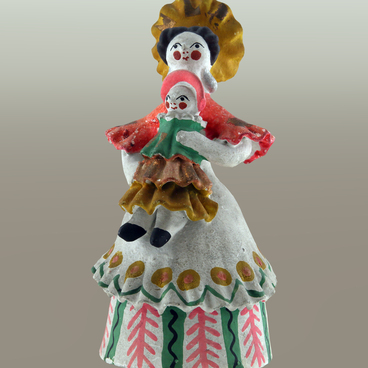Among all the toys of the Sergiev Posad craftsmen, there is one special inseparable couple — a gallant hussar and an elegant lady. Unlike cheap figurines made from waste materials, this hussar is a toy of a higher level: it is made with great care and attention to small details. Starting from the top of a lancer cap and ending with the textured image of a pelisse (a short hussar cape) — everything is painted with expensive dyes. The dashing mustache, the lacing on the uniform, the elements of the headdress, and the richly decorated saber are skillfully drawn. Nevertheless, the figure also has some generalized features: the artisan added epaulettes to the uniform, the clasps on the dolman are made crosswise, and the pelisse is depicted on the right shoulder. In addition, the artist provided the “hussar” with a rather unusual headdress — a fantasy hybrid of a shako and a lancer cap.
Toy production centers appeared near large cities, in settlements and suburbs, and developed under the strong influence of urban culture. Woodcarving had been practiced in Sergiev Posad for a long time, and by the 19th century it became the largest center of the production of Russian carved wooden toys. There were many good carvers, who worked at large workshops. In addition to carved “bolvashki” — molds for creating papier-mâché works, the artisans carved wooden toys, distinguished by realistic images and bright colors: expensive toys were enameled, and cheaper ones were glued. The artisans used a variety of carving techniques, using a knife and different chisels. This enabled them to convey the forms and textures of complex costumes, fabrics, ribbons, and fur. The craftsmen used engravings from paintings by Western and Russian artists, as well as clippings from fashion magazines as sources of inspiration. The white hands and faces and the shiny surface made the toys look like the costly china they imitated.
Expressive faces, rich outfits, and romanticization of the image of the Patriotic War of 1812 — all these features allow the Sergiev Posad hussar with the lady to be called one of the best works of folk art of the 19th century.
Toy production centers appeared near large cities, in settlements and suburbs, and developed under the strong influence of urban culture. Woodcarving had been practiced in Sergiev Posad for a long time, and by the 19th century it became the largest center of the production of Russian carved wooden toys. There were many good carvers, who worked at large workshops. In addition to carved “bolvashki” — molds for creating papier-mâché works, the artisans carved wooden toys, distinguished by realistic images and bright colors: expensive toys were enameled, and cheaper ones were glued. The artisans used a variety of carving techniques, using a knife and different chisels. This enabled them to convey the forms and textures of complex costumes, fabrics, ribbons, and fur. The craftsmen used engravings from paintings by Western and Russian artists, as well as clippings from fashion magazines as sources of inspiration. The white hands and faces and the shiny surface made the toys look like the costly china they imitated.
Expressive faces, rich outfits, and romanticization of the image of the Patriotic War of 1812 — all these features allow the Sergiev Posad hussar with the lady to be called one of the best works of folk art of the 19th century.



